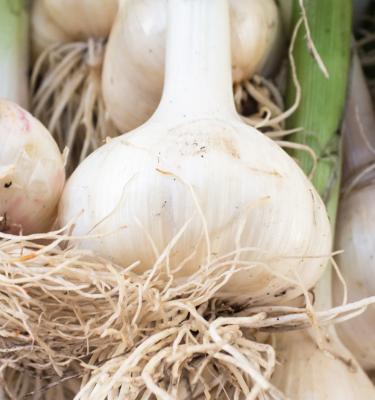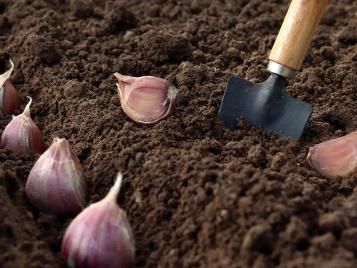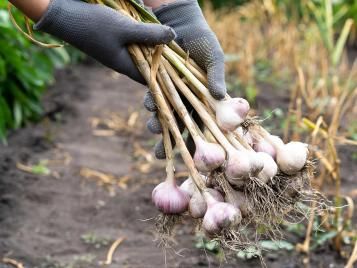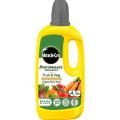

How To Grow and Plant Garlic With Our Simple Steps
Garlic is the base of so many delicious dishes, and growing garlic (Allium sativum) at home is now very popular. It’s an easy vegetable to grow – just plant a garlic clove into the soil, wait a few months and you’ll be rewarded with a bulb of up to a dozen or more cloves ready to use in the kitchen.
Hardneck and softneck garlic
Garlic bulbs are divided into hardneck and softneck varieties. Hardneck garlics produce a flowerspike, essentially a long stem growing up from the bulb and bearing a flowerhead. Softneck garlics don’t produce flowerspikes, so the ‘neck’ of these bulbs stays soft and flexible.
Hardneck bulbs are hardier than softnecks, so are a good choice for areas with cold winters. The bulbs often have stronger, more complex flavours than softneck garlics. On the downside, the bulbs don’t store as well as softnecks do.
Softneck garlics are best grown in mild areas. The bulbs tend to have a mild flavour and can be stored for several months. Garlic bulbs sold in supermarkets are usually softneck varieties.
Hardneck garlic varieties to grow
- Garlic ‘Early Purple Wight’ – a robust variety, ready to harvest in early summer
- Garlic ‘Sprint’ – fast-growing, with large pink cloves
Softneck garlic varieties to grow
- Garlic ‘Arno’ – medium-flavoured pink cloves
- Garlic ‘Marco’ – white-skinned, with a strong flavour
- Garlic ‘Germidour’ – large white bulbs, mild flavour
How to grow garlic

Begin by splitting the bulb carefully into individual clove segments, and then gently push each clove into the soil, so the tip is just below the soil surface, with the clove facing end-up and the flatter basal plate facing down. Allow a gap of 15cm (6in) between each clove and 20-30cm (8-12in) between each row of cloves.
Garlic growing equipment list
To grow garlic in your garden you will need:
- Spade
- Fork
- Garlic bulbs
- Supply of well-rotted farmyard manure or other soil improver such as Levington Organic Blend Farmyard Manure
- General-purpose fertiliser
- Horticultural fleece or cloches
How to plant garlic
Garlic does best in a fertile, well-drained soil in full sun. The bulbs need a period of cold weather in order to grow, so the best time to plant garlic is in autumn, although there are some varieties that have been bred for spring planting.
- Before planting garlic, prepare the soil by digging in plenty of compost or well-rotted farmyard manure. If your soil is very heavy clay, add grit, or plant bulbs in containers instead.
- Remove any weeds and stones.
- Apply a general-purpose fertiliser in accordance with the manufacturer’s instructions, and rake in.
- Break the garlic bulbs into individual cloves.
- Plant the cloves 15cm (6in) apart and 2.5cm (1in) deep, with tips just below the surface and pointing upwards. Space rows 30cm apart.
- Water after planting, to help settle the soil around the cloves.
- Cover the area with horticultural fleece or cloches to stop birds pulling up the seedlings as they appear. Once the plants grow larger, they are less attractive to birds and the protection can be removed.
Growing garlic in containers
Garlic will grow happily in containers outdoors, and this is a good option in gardens where the soil is very heavy and wet.
- Choose a container at least 30cm in diameter and 20cm deep, with good drainage holes.
- Fill with a good quality multipurpose compost and add a slow-release fertiliser.
- Plant the cloves 10-15cm (4-6in) apart and 2.5cm (1in) deep, with tips just below the surface and pointing upwards. Don’t plant bulbs right up against the edge of the container – leave space for them to swell as they grow.
- Water regularly to keep the compost moist.
Caring for garlic
Once planted, garlic doesn’t need much looking after. Just follow these simple steps for a good crop:
- Keep beds weed-free. Remove weeds by hand to avoid damaging the bulbs with a hoe.
- Water during long dry periods.
- Stop watering once the leaves start turning yellow and the bulbs start to swell.
- On hardneck bulbs, pick any flowerscapes before they flower, to keep the plant’s energy focused on developing the bulb. The flowerscapes are edible and very tasty!
Harvesting garlic

While garlic is growing, you can harvest a leaf now and then to add to salads, but don’t take too many at a time from any one plant.
Flowerscapes should be picked before the flowers develop. The scapes have a mild garlic flavour and can be cooked or chopped up and added raw to salads.
The garlic bulbs themselves should be ready to harvest from early summer. To know when to harvest garlic, look at the plants’ leaves – when they turn yellow, the garlic is ready to be harvested.
To harvest garlic, use a garden fork to gently lift the bulbs.
How to store garlic
- Before storing garlic, lay the bulbs outside in the sun on a rack, or inside in a well-ventilated shed, to allow them to dry out. This will take two to three weeks.
- Once the skins are dry and papery, the bulbs are ready to be stored. Remove any damaged or bruised bulbs.
- Store garlic bulbs in a string bag in a cool, dry, dark place.
Common garlic diseases
Although garlic is easy to grow, there are a few diseases that can cause problems.
White rot
White rot is a fungal disease that rots garlic bulbs and causes leaves to turn yellow and die. Unfortunately, there’s no treatment available for this. Burn all affected plants and don’t plant garlic or other allium bulbs in that soil for at least eight years.
Leek rust
Leek rust, another fungal disease, causes orange blotches on leaves. Mild cases will not necessarily affect the crop but remove any affected leaves as soon as you see them and burn or dispose of them (but not on a compost heap). Leek rust is more common in long periods of wet weather, and on overcrowded plants. Avoid planting garlic or other alliums in affected soil for at least three years.
Key features of garlic
| Flowering season(s) | Spring, Summer |
|---|---|
| Foliage season(s) | Spring, Summer, Autumn |
| Sunlight | Full shade, Partial shade, Full sun |
| Soil type | Chalky, Clay, Loamy, Sandy |
| Soil pH | Neutral |
| Soil moisture | Moist but well-drained |
| Ultimate height | Up to 45cm (18in) |
| Ultimate spread | Up to 10cm (4in) |
| Time to ultimate height | 6 months |




